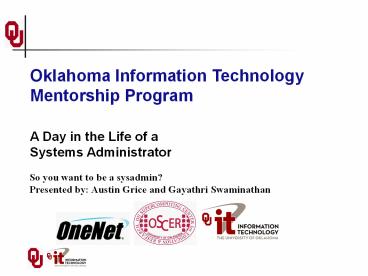A Day in the Life of a PowerPoint PPT Presentation
Title: A Day in the Life of a
1
Oklahoma Information Technology Mentorship Program
A Day in the Life of a Systems Administrator
So you want to be a sysadmin? Presented by
Austin Grice and Gayathri Swaminathan
2
whois austin
3
whois gayathri
- Programmer Analyst
- Junior systems administrator
- Remote applications engineer
- Systems Engineer
- worked in Unix/Linux since 2002
- performed large scale deployments since 2004
- implemented ERPs since 2008
4
What is a sysadmin?
System users
Applications
DBA
Storage
Operations
Systems Engineer
Network
Security
Analysts
Developers
Image credithttp//personalpages.manchester.ac.uk
/staff/m.dodge/
5
whereis problem
Image creditPrologue Films VFX for Marvel Studios
6
grep clues
- Large infrastructure tied to service(s)
- Constant refresh projects
- Inconsistent or specific configurations
- Tough to measure and metric
- Tough to scale
- No hope for automation
- How do you document mammoth architectures of
different types? - Instant large learning curve for new hires
7
find solutions
Adjust the perspectives!
Credithttp//www.hubblesite.org/
8
diff solution1 solution2 solution3...
- - Monitor monitor monitor
- - System profiling
- - Isolated test environment
- Figure initial requirements
- Record behaviors
- Analyze metrics and identify the useful ones
- Develop architecture
- Narrow design constraints
- Benchmark
- Load and regression tests
- - A great place to get your teams to
collaborate!
9
which solution
10
Model system
10
Standard host profiles
Hypervisor OS
Standard storage profile
Standard network profile
Standard system profile
Standard metrics and monitors
Credit http//www.flickr.com/photos/jonfisher/465
778825/sizes/z/in/photostream/
11
vi behavior
12
Iterative life cycle
Gather requirements
Profile system
Dependencies
Define metrics
Discuss placement of Security controls
Collect system behaviors
Expect non-predictable behaviors
Start communications on integrations
Initiate conversations on external interfaces
13
Tool chest
14
Now we have been introduced...
A few questions to you!
- How many of you can play a musical instrument?
- Do you keep a log of number of lines of code
you have written?
- Who uses your code?
- Who could use your code?
- Raise your hand if you ever thought, I could
write software for that!
- How many of you use Linux?
- How many of you use Unix/Linux?
- How many of you have been in white board
sessions with your professor or classmates?
15
The Unix Philosophy
- Small is beautiful.
- Make each program do one thing well.
- Build a prototype as soon as possible.
- Choose portability over efficiency.
- Store numerical data in flat ASCII files.
- Use software leverage to your advantage.
- Use shell scripts to increase leverage and
portability. - Avoid captive user interfaces.
- Make every program a filter.
- Credit Mike Gancarz
- Also refer Notes of programming in C - Rob Pike
- - http//www.lysator.liu.se/c/pikestyle.html

